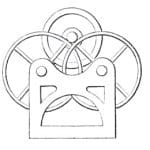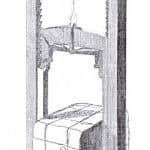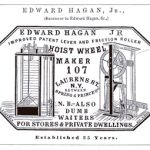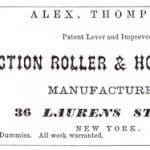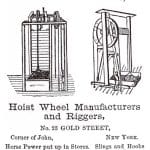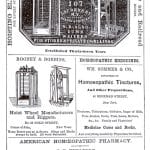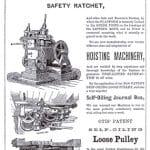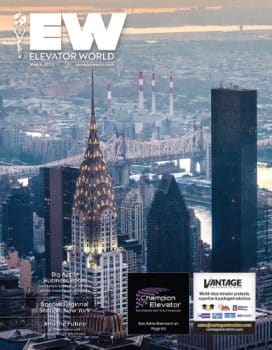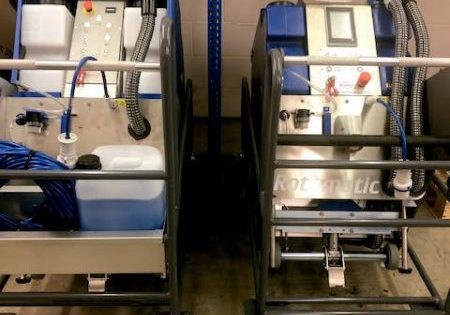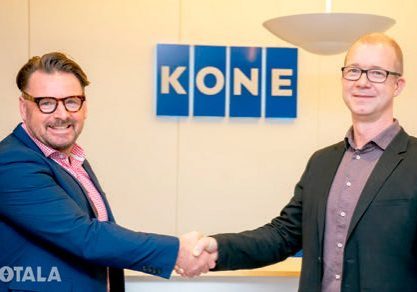Elevator Manufacturing in NYC
Mar 1, 2020

This History article examines the little-known situation of the fledgling industry between 1836 and 1869.
by Dr. Lee Gray, EW Correspondent
The November 25, 1854, issue of Scientific American included an illustrated, descriptive article on Elisha Graves Otis’ “improved elevator,” which he had recently exhibited at the New York Crystal Palace. The story of Otis’ exhibition has become a staple component of all histories of vertical transportation (VT), as well as the stuff of legend and myth. The successful demonstration of his new safety device is typically described as having offered a powerful commercial challenge to existing elevator builders. However, very little is known about elevator manufacturing in New York in the mid-1800s. Who were Otis’ competitors? What was the state of the VT industry? The following account will seek to answer these questions through an examination of the elevator industry in NYC from 1836 to 1869, seen primarily through the lens of the city’s commercial directories.
At the Ninth Annual Fair of the American Institute, held in October 1836, M.N. Stanley & Co. received a Silver Medal for “an excellent hoisting machine on a new principle.”[1] The hoist, invented by Henry Stanley, was advertised as “Stanley’s patent hoisting machine.” While designed for use in warehouses, it was also described as suitable for “many other purposes.”[2] The “new principle” employed by Stanley was described as follows:
“The superiority of this machine over those ordinarily in use consists in its having two motions or powers and can be instantly shifted from one to the other to conform to the weight of the article to be hoisted — the advantages of which are that light articles can be hoisted very rapidly and heavy articles without additional labor.”[2]
Unfortunately, no images of Stanley’s hoisting machine have survived, and the patent alluded to remains a mystery. While patents attributed to Henry Stanley from this period exist, none concern hoisting machines. It is very likely that this device concerned a basic hoist that did not feature a platform, but which employed a hook or other means to carry loads.
By the end of the 1840s, numerous individuals and companies in NYC were engaged in manufacturing hoists and hoisting components, and entries in the city’s business directories reflect the gradual emergence of this new industry. Edward Hagan and Edward Thomas described themselves as hoist wheel (sheave) makers M.N. Stanley & Co. was joined by Thomas W. Fields and Daniel Mahoney as advertised builders of hoisting machines. Fields also advertised that he manufactured “improved patent” levers, friction rollers and hoist wheels. (As was the case with Stanley, relevant patents assigned to Fields have not been found). The reference to friction rollers serves as a reminder of the increasing complexity of these machines. A friction roller (also occasionally referred to as an “antifriction roller”) was defined as: “Instead of a shaft revolving in an ordinary bearing, it is supported on the circumference of wheels [or rollers]. The friction is thus reduced to the least amount.”[3] (Figure 1)
The NYC elevator industry continued to grow throughout the 1850s. Hagan and Thomas expanded their production to include hoisting machines, and additional manufacturers appeared on the scene. The latter included Mahoney, Edwin R. Thomas, Henry C. Flenda, Thompson & Crawford and Otis, whose entry into this increasingly crowded marketplace was aided by the 1854 Scientific American article, which included the first published image of an American platform freight elevator (Figure 2). Otis used this image in an 1855 leaflet that announced the creation of the Union Elevator Works and General Machinery Depot. In 1857, he described himself in the NYC directory as a “manufacturer of improved patent elevators and hoisting machines that cannot fall.”[4] Otis was, in fact, the only manufacturer in 1850s NYC who advertised “elevators” and “hoisting machines.” The difference between these types appears to have been the presence of a platform (instead of a hook, net or basket) used to carry the load. Otis also (as was evident in his company’s name, which included the phrase “general machinery depot”) followed the precedent established by his competitors in manufacturing a wide range of products.
These included steam engines, boilers, shafting and pulleys, iron turning lathes, planning, slotting and drilling machines, and bolt cutters.
Unfortunately, Otis did not live to see his fledgling company’s eventual success under the leadership of his sons. He died on April 8, 1861. Four days later, Confederate troops opened fire on Fort Sumter, and the nation was plunged into four years of Civil War. Following the end of the war in April 1865, NYC’s elevator industry, largely dormant during the war years, began a second phase of expansion. However, before the immediate postwar era is examined, one event from the early 1860s should be noted. In 1861, S.B. Althause & Sons Iron Works advertised that the wide range of products it manufactured included “platform elevators, both geared and hydraulic.”[5] This brief statement marks two potential “firsts.” It is one of the earliest references to a geared machine (powered by a steam engine) in an era when most elevators were belt-driven machines. The statement also includes one of the first references to a hydraulic elevator system. Unfortunately, no images or other information that could shed light on these intriguing systems has survived.
The first illustrated elevator advertisement appeared in a NYC directory in 1866. The advertisement, for the firm of Edward Hagan, Jr. (successor to Edward Hagan, Sr.), featured two images: one depicting a hand-powered elevator and one depicting a hand-powered hoisting machine (Figure 3). A close reading of these engravings reveals that they appear to contain the normative components of hand-powered machines. The elevator featured a large hoisting sheave driven by an endless rope, a brake, a car and a counterweight, while the hoisting machine employed a winding drum and hook. This reading also reveals that the drawings are somewhat crudely done regarding accuracy and detail. For example, in both cases, the human figure allegedly powering the machine is not, in fact, grasping the hoisting rope. The advertisement’s text described Hagan as a maker of “improved patent” levers, friction rollers and hoist wheels. The text further stated that he manufactured “hoisting elevators for livery stables, carriage and railroad houses,” as well as “dumbwaiters for stores and private dwellings.”[6]
The 1867 advertisement for Alexander Thompson, who described himself as a “patent lever and improved friction roller & hoist wheel manufacturer,” included an illustration of a hand-powered hoisting machine (Figure 4).[7] While somewhat schematic in nature, this image accurately represented the act of hoisting, with the human figure grasping the rope in their hands. The image also appears to represent a machine similar in design (although seen from a different perspective) to that found in the Hagan advertisement. In fact, the engravings produced for the Hagan advertisement by L.B. Covert were recycled for an 1868 advertisement for Rooney & Dobbins (Figure 5). Remarkably, the advertisements for both firms appeared on the same page in the 1868 directory, with the images differentiated only in their graphic presentation (Figure 6). This set of images continued to be used throughout the 1870s in advertisements for different firms and served as generic representations of this technology.
These generic images were eclipsed in 1868 by the appearance of the first illustrated advertisement for Otis Brothers & Co. to appear in a NYC directory (Figure 7). Beginning in the early 1860s, Otis had adopted a strategy of investing in the production of high-quality images that accurately represented its products. Many of these first appeared in Figure 3: Edward Hagan, Jr. advertisement (1866) industrial and mechanical journals and accompanied articles that extolled the virtues of their elevators. The images were later used in advertisements and promotional materials. The 1868 advertisements featured images depicting a steam hoisting engine and two belt-driven, ceiling-mounted machines. The content of the advertisements’ text departed from their typical practice of describing and identifying the products by name (for example, the “Union Hoisting Engine”). Instead, they offered potential customers a general introduction to Otis Brothers & Co.:
“Successors to E. Graves Otis, original inventor of the safety ratchet, and other safe and economical devices, by which the platform is instantly locked to the guide posts on the breakage of the lifting rope, and no power is consumed, excepting what is actually required to do the work. We are now manufacturing over 20 different sizes and adaptations of hosting machinery and are enabled by long experience and thorough knowledge of the business to guarantee unqualified satisfaction in all cases. By the application of our new patent self-oiling loose pulley, and also a very superior self-oiling journal box, we can warrant our machines to run in the most perfectly satisfactory manner, with oiling but once a week. Otis’ patent self-oiling loose pulley is the most perfect contrivance for the purpose ever invented and will be found invaluable in manufactories, etc. where disordered loose pulleys are found to be a source of constant annoyance.”[8]
Among the companies that joined the NYC elevator industry in the 1860s were firms that sought to capitalize on the growing number of elevators in the city by offering installation and repair services. These included Charles West, who advertised that he could repair “elevators of all kinds.” West also noted that he installed call-bells, speaking tubes, whistles, signs, office doors and rolling shutters. He also offered his services as a locksmith and a gas fitter with, of course, “all orders promptly attended to and executed with dispatch.”[8] In a similar fashion, John N. Blasi, a self-described engineer and machinist, stated that his wide range of services included the repair and installation of “elevators and machinery of all kinds. . . at the shortest notice.”[9] New elevator companies included William S. Watson, “manufacturer of Watson’s patent elevator, patent safety self-acting hoisting and lowering apparatus, hand & steam hoisting machines, parallel vices, etc.” and L. Atwood & Co., “builders of Atwood’s patent differential elevators for hotels, stores and public buildings.”[8 & 9]
This brief survey of the origins of NYC’s elevator industry illustrates its diversity and reminds us that important events, such as Elisha Graves Otis’ 1854 exhibition, occur within unique and distinct historical contexts. While the importance of NYC in the development of elevator technology in the last quarter of the 19th century is well-known, this investigation uncovered a fact that speaks to the industry’s national importance in the early 1870s. In 1873-1874, L. Atwood & Co. installed the first passenger elevator in the Capitol building in Washington, D.C. But that, as they say, is a story for another day.
- Figure 1: Friction roller (1868)
- Figure 2: Elisha Graves Otis’ “Improved Elevator” (1854)
- Figure 3: Edward Hagan, Jr. advertisement (1866)
- Figure 4: Alexander Thompson advertisement (1867)
- Figure 5: Rooney & Dobbins advertisement (1868)
- Figure 6: Hoisting Machines advertisement (1868)
- Figure 7: Otis Brothers & Co. advertisement (1868)
References
[1] “List of Premiums Awarded by the Managers of the Ninth Annual Fair of the American Institute held at Niblo’s Garden, October 1836,” Journal of the American Institute (November 1839).
[2] “Stanley’s Patent Hoisting Machine,” New York Post (July 13, 1836).
[3] Henry T. Brown, Five Hundred and Seven Mechanical Movements, San Francisco: Dewey & Co. (1869).
[4] Trow’s New York City Directory, Compiled by H. Wilson, for the Year Ending May 1, 1857, New York: John F. Trow (1857).
[5] Trow’s New York City Directory, Compiled by H. Wilson, for the Year Ending May 1, 1861, New York: John F. Trow (1861).
[6] Trow’s New York City Directory, Compiled by H. Wilson, for the Year Ending May 1, 1866, New York: John F. Trow (1866).
[7] Trow’s New York City Directory, Compiled by H. Wilson, for the Year Ending May 1, 1867, New York: John F. Trow (1867).
[8] Trow’s New York City Directory, Compiled by H. Wilson, for the Year Ending May 1, 1868, New York: John F. Trow (1868).
[9] Trow’s New York City Directory, Compiled by H. Wilson, for the Year Ending May 1, 1869, New York: John F. Trow (1869).
Get more of Elevator World. Sign up for our free e-newsletter.
